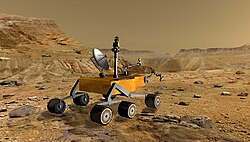PIA17594-MarsCuriosityRover-JohKleinMudstoneDrillHole-20130510
http://photojournal.jpl.nasa.gov/catalog/PIA17594
The hole that NASA's Curiosity Mars rover drilled into target rock "John Klein" provided a view into the interior of the rock, as well as obtaining a sample of powdered material from the rock. The rock is part of the Sheepbed mudstone deposit in the Yellowknife Bay area of Gale Crater. This image, taken by Curiosity's Mars Hand Lens Imager (MAHLI) camera, reveals gray colored cuttings, rock powder and interior wall. Notice the homogeneous, fine grain size of the mudstone, and the irregular network of sulfate-filled hairline fractures. A vertical array of pits in the side of the hole resulted from using the laser-shooting Chemistry and Camera (ChemCam) instrument to assess composition at those points. The MAHLI took this image during the 270th Martian day, or sol, of Curiosity's work on Mars (May 10, 2013). The diameter of hole is about 0.6 inch (1.6 centimeters).
The Sheepbed mudstone is interpreted to represent an ancient lake. It preserves evidence of an environment that would have been suited to support microbes that get their energy by eating chemicals in rocks. This wet environment was characterized by neutral pH, low salinity, and variable oxidation of iron- and sulfur-containing minerals. Carbon, hydrogen, oxygen, sulfur, nitrogen and phosphorus were measured directly as key elements for supporting possible life. These results highlight the biological viability of fluvial-lacustrine environments (streams and lakes) in the history of Mars after the earliest era of the Martian past, called the Noachian Era.
Malin Space Science Systems, San Diego, developed, built and operates MAHLI. NASA's Jet Propulsion Laboratory, Pasadena, Calif., manages the Mars Science Laboratory Project and the mission's Curiosity rover for NASA's Science Mission Directorate in Washington. The rover was designed and assembled at JPL, a division of the California Institute of Technology in Pasadena.
More information about Curiosity is online at http://www.nasa.gov/msl and http://mars.jpl.nasa.gov/msl/.Relevante Bilder
Relevante Artikel
Mars Science LaboratoryMars Science Laboratory ist eine NASA-Mission im Rahmen des Flagship-Programms, die den Mars hinsichtlich seiner aktuellen und vergangenen Eignung als Biosphäre erforscht. Hierzu wurde auf der Oberfläche ein weitgehend autonomer Rover mit dem Namen Curiosity abgesetzt, der mit zehn Instrumenten zur Untersuchung von Gestein, Atmosphäre und Strahlung ausgerüstet ist. Zu deren Analyse kommen neben einer großen Zahl unterschiedlicher Spektrografen auch Kameras und meteorologische Instrumente zum Einsatz, welche die Messdaten für die Auswertung zur Erde schicken. Mit einer Masse von 900 kg und der Größe eines kompakten Kleinwagens war Curiosity bis zur Landung von Perseverance im Februar 2021 das schwerste von Menschen geschaffene Objekt auf der Marsoberfläche und löste die Viking-Tochtersonden mit je knapp 600 kg ab. .. weiterlesen










































